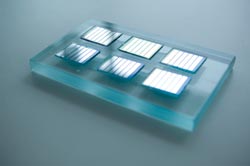Hybrid organic solar cells made of plastic may help “green” the solar industry. Although plastics are generally made of petroleum, one could debate whether plastic solar is moving in a cleaner, greener direction. It is possible that plastics may be the answer, especially understanding that the manufacture of each tiny silicon chip results in 1.7 kg of greenhouse gases, according to an article published in 2002 in the American Chemical Society’s Journal of Environmental Science & Technology.

Plastic solar cells, currently under development at the University of Alberta, may be an environmentally friendly alternative to silicon cells. Photo courtesy of Michael Holly, University of Alberta.
A group at the University of Alberta in Edmonton, Canada, and at the National Research Council’s National Institute for Nanotechnology (NINT), located at the university, is working on improving the performance of plastic solar cells. Jillian M. Buriak, a professor of chemistry at the university and an NINT principal investigator, describes plastic solar cells as being like “a clubhouse sandwich.”
Each layer has a function, whether to absorb light, generate electricity or draw the electricity out of the device. In traditional plastic designs, the layers don’t stick well, and the devices are less efficient than they could be.
Buriak said that her group is working on “the mayonnaise, the mustard, the butter … that bring the sandwich together.” So far, the researchers have seen improvements in efficiency of about 30 percent.
When asked whether plastic solar cells would be less toxic than silicon and highly recyclable, Buriak noted that, “Considering that many soon-to-be commercial solar cells on the market are made of CIGS (cadmium indium telluride sulfide) and cadmium telluride, our benign plastics are a heck of a lot less toxic.”
The Canadian research team estimates that it will be five to seven years before plastic solar panels are mass-produced. At that point, Buriak surmised, solar will be available to everyone because the materials are inexpensive, and panels can be made in massive quantities using ink-jet printing technology.